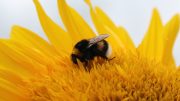 Buzz! Buzz! What’s the buzz about bees? In order for plants to reproduce, they must be pollinated, and honeybees are one of the most important pollinators. Humans consume many crops that require pollination. Additionally, we eat meat from animals that are fed grains and grass that are also pollinated by honeybees.
Buzz! Buzz! What’s the buzz about bees? In order for plants to reproduce, they must be pollinated, and honeybees are one of the most important pollinators. Humans consume many crops that require pollination. Additionally, we eat meat from animals that are fed grains and grass that are also pollinated by honeybees.
Unfortunately, we have lost many of our honeybees. Several factors, including the use of pesticides, are blamed for the loss of honeybees, and these issues must be addressed. However, the major challenge facing the permanent survival of bees is climate change.
In fact, our survival as a species may be threatened by the effects of climate change on bees. Exactly how much of our food supply is dependent on crops pollinated by bees?
A United Nations Environment Programme report stated that bees pollinate 70% of the world’s top 100 staple food crops. Worldwide, the economic value of bee’s pollination has been estimated to be around € 265 billion annually. Obviously the survival of bees is important to Europe. The European Union produces 13% of the world’s honey, with Spain being the major exporter.
Through a glance at agriculture in the United States, we can get a picture of the financial value of bees. According to the Xerces Society for Invertebrate Conservation, honey bees contribute $20 billion annually to the economy of the United States through the pollination of vegetables, fruit trees, flowers, and agricultural row crops. Some of these crops are tomatoes, melons, oranges, apples, strawberries, blueberries, onions, carrots, beans, broccoli, cucumbers, sweet potatoes and pumpkins.
Almonds and alfalfa are extremely important crops and are pollinated by bees. California, with 100,000 acres of almond trees, produces almonds worth $3 billion per year. Alfalfa is worth more than $8 billion each year, not including its value as feed for dairy and beef cattle. In 2012, the value of Wisconsin alfalfa hay production was $382 million dollars.
How does climate change affect the relationship between bees and plants? Climate change affects pollination by disrupting the synchronized timing of flower blooming and the timing of when bees are available to pollinate. Tim Levett, director of Public Affairs at the British Beekeeper’s Association, stated that “The wrong weather at the wrong time can be very bad for bees.
One of the major causes of loss among honeybees in the spring is starvation. There are suddenly thousands of new mouths to feed. If they wake early and the plants are still asleep, then there is trouble. Likewise, if the plants awake early and the bees are still asleep and miss the first flush, then there can also be trouble.”
Simon Potts, Professor of Biodiversity and Ecosystem Services at Reading University in the United Kingdom, stated that “Under climate change you would expect habitats that bees and pollinators use will shift—but the bees may or may not be able to move; there may be no connection between the habitat they have now and the new area. Both the bees and flowering plants are shifting because of climate, but, on average, the UK flowers are [blooming] earlier by 4 or 5 days each decade whereas the bees we have looked at are [emerging] earlier by 7-10 days per decade.” The environmental group Friends of the Earth has calculated that if all bees were wiped out in the United Kingdom, it would cost $2.81 billion to hand-pollinate food crops in their place.
Honeybees are not the only species of bees affected by climate change. Wild bees are also important for crop pollination, and they improve the flavor and quality of fruits such as apples. Wild bees may actually be more susceptible to climate change than honey bees, with bumblebees being even more vulnerable.
According to Jeremy Kerr, a biodiversity researcher at the University of Ottawa in Canada, climate change is “crushing bumblebees in a kind of climate vice.” Kerr also warns that bumblebees “just aren’t colonizing new areas and establishing new populations fast enough to track rapid human-caused climate change. Impacts are large and they are underway. They are not just something to worry about at some vague, future time.”
Aside from causing disruptions in the plant-pollination relationship of bees and flowers, climate change could even make the parasites that infect honeybees more virulent.
For example, Robert Paxton, a biologist and co-author of a study published in the Proceedings of the Royal Society B, studied several types of organisms which prey on bees. Paxton stated that “Clearly, in Britain and the United States, if the temperature is warmer, it means that the exotic [species of] parasite, which has been suggested to be more virulent, will predominate or become more prevalent.”
Since bees are so important to the food chain, it is important that their numbers be maintained. Over a long period of time, each species of bee has evolved to fit into their specific environmental niche. Climate change may not give them enough time to evolve to their rapidly changing habitat, and thus threatens their survival.
Lenore M. Hitchler




Be the first to comment on "Bee Active! Fight Against Climate Change"